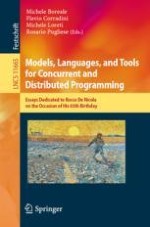2019 | OriginalPaper | Buchkapitel
Embedding RCC8D in the Collective Spatial Logic CSLCS
verfasst von : Vincenzo Ciancia, Diego Latella, Mieke Massink
Erschienen in: Models, Languages, and Tools for Concurrent and Distributed Programming
Aktivieren Sie unsere intelligente Suche, um passende Fachinhalte oder Patente zu finden.
Wählen Sie Textabschnitte aus um mit Künstlicher Intelligenz passenden Patente zu finden. powered by
Markieren Sie Textabschnitte, um KI-gestützt weitere passende Inhalte zu finden. powered by
Abstract
topochecker, a model-checker for CSLCS, can be used for effectively checking the existence of a RCC8D relation between two given regions of a discrete space.
 for the “share” connective, and
for the “share” connective, and